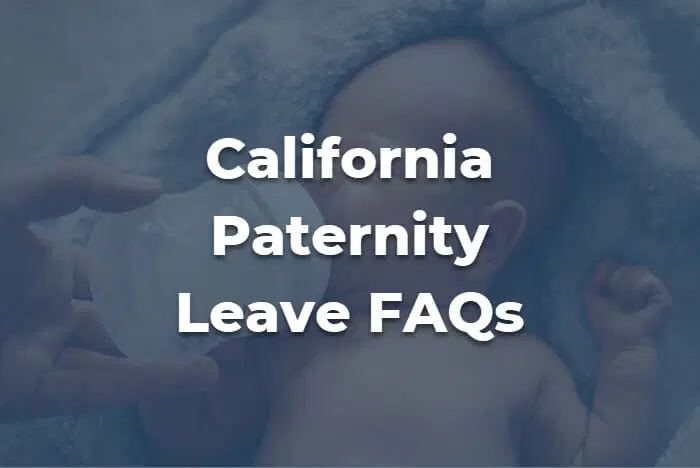
22 California Paternity Leave FAQs
Legally reviewed by: Jessica Anvar Stotz, JD, MBA
As a certified California attorney referral service, we have heard many questions about how paternity leave works and the rights you have according to California law. Below is a list of common and uncommon questions (as well as answers) we have heard to help answer any you might have.
1. How does California law define paternity leave?
Paternity leave in California refers to the time off granted to fathers to bond with and care for their newborn child, as protected under the state’s family leave and employment laws.
This is an important benefit that allows fathers to take time off work to bond with their newborn child and support their partner during the early stages of parenthood.
2. Who is eligible for paternity leave in California?
Employees who work for a covered employer and have completed a minimum of 1,250 hours of service in the past year are generally eligible.
3. How much time off can a father take for paternity leave in California?
Eligible fathers can take up to 12 weeks of unpaid leave within one year following the birth, adoption, or foster care placement of a child.
4. Is paternity leave paid or unpaid in California?
Paternity leave in California is generally unpaid; however, eligible employees can receive partial wage replacement through the state’s Paid Family Leave (PFL) program.
If a father meets the eligibility criteria for California’s Paid Family Leave program, he may receive benefits for a maximum of eight weeks. These benefits are calculated based on a percentage (typically 60-70%) of the father’s average weekly wages earned over a specific period, ranging from 5 to 18 months.
5. How is paternity leave different from other types of leave, such as family leave or sick leave?
Paternity leave specifically applies to bonding with a newborn, adopted, or foster child, while other types of leave may cover a broader range of family or personal medical reasons.
6. Can both parents take leave simultaneously?
Yes, both parents can take leave simultaneously, but the combined total cannot exceed the 12 weeks of leave.
7. Can an employee be fired or penalized for taking paternity leave?
No, it is illegal for an employer to retaliate or discriminate against an employee for taking paternity leave.
8. How does paternity leave interact with other types of leave, such as vacation time or disability leave?
Employers generally cannot require employees to use vacation or sick time for paternity leave, and it is separate from disability leave, which may be applicable for a mother’s recovery from childbirth.
9. Are self-employed individuals or independent contractors eligible for paternity leave?
Self-employed individuals and independent contractors are not covered by the state’s paternity leave laws but can voluntarily participate in the PFL program.
10. What documentation is required to apply for paternity leave?
The required documentation typically includes a completed claim form and certain details like the child’s birth or placement information.
11. Can paternity leave be taken intermittently or does it need to be taken consecutively?
Paternity leave can be taken intermittently, subject to the employer’s approval, as long as it is taken within one year of the child’s birth, adoption, or placement.
12. Can my employer deny paternity leave?
According to California law, eligible employees have the right to paternity leave, and it is generally illegal for employers to deny or retaliate against an employee for taking paternity leave.
13. Can an employer require an employee to use their vacation or sick time instead of paternity leave?
Generally, employers cannot require employees to use their vacation or sick time for paternity leave, but employees may choose to use their accrued leave for compensation during the period.
14, How much notice do I need to give before taking paternity leave?
Under California law, if the need for paternity leave is foreseeable, such as for a planned adoption or foster care placement, employees generally need to provide their employer with reasonable advance notice.
The specific amount of notice required may vary depending on the circumstances, but it is recommended to inform the employer as soon as possible to allow for proper planning and coordination.
15. How does paternity leave affect health insurance coverage?
During paternity leave, the employer is required to maintain the employee’s health insurance benefits under the same conditions as if the employee were actively working.
16. Are there any specific requirements for the employer regarding providing paternity leave?
Covered employers must provide eligible employees with the right to take paternity leave and maintain their job position or a similar one upon return.
17. Can paternity leave be taken for adoptions or foster care placements?
Yes, paternity leave can be taken for adoptions or foster care placements, as long as the employee is eligible and meets the necessary criteria.
18. How does paternity leave impact job protection and the right to return to the same position after leave?
Employees who take paternity leave generally have job protection and the right to return to the same position or a comparable one with equivalent pay, benefits, and terms upon their return.
19. How Long is Paid Paternity Leave in California?
Paid paternity leave in California typically provides eligible employees with up to eight weeks of partial wage replacement through the state’s Paid Family Leave (PFL) program.
20. Are there exceptions to this?
Yes, there are exceptions to the length of paternity leave in California. While the standard duration of paternity leave under the state’s Paid Family Leave (PFL) program is up to eight weeks, the actual length of leave can vary based on several factors.
For example, an employee’s individual circumstances, such as their employer’s policies, collective bargaining agreements, and the availability of other benefits, can affect the duration of paid paternity leave. Additionally, employees may have the option to take additional unpaid leave beyond the PFL period if they are eligible under the California Family Rights Act (CFRA) or other applicable laws.
21. What should I do before taking paternity leave?
Below are some important steps to consider before taking paternity leave:
- Review company policies: Familiarize yourself with your employer’s policies regarding paternity leave, including the duration, eligibility criteria, and any required documentation or notification procedures. This information can typically be found in the employee handbook or through discussions with your HR department.
- Understand legal rights: Knowing your rights and entitlements will help you make informed decisions about the duration and terms of your leave.
- Communicate with your employer: Notify your employer as early as possible about your intention to take paternity leave. Provide clear details regarding the expected duration, start date, and any specific scheduling preferences you may have. Open communication will allow your employer to plan for your absence and ensure a smooth transition.
- Coordinate with your partner: Discuss your paternity leave plans with your partner to ensure you can coordinate your time off effectively. Consider factors such as the mother’s maternity leave, any shared leave arrangements, and how you can best support each other during this period.
- Financial planning: Assess your financial situation and explore available options for income replacement during your leave. This may include utilizing paid time off, considering state disability insurance (SDI) benefits, or exploring other sources of financial support.
- Prepare for workload management: Prioritize and delegate tasks before your leave begins to ensure a smooth transition for your colleagues and minimize any potential disruptions. Communicate with your team, provide necessary information, and document key processes or responsibilities to facilitate a seamless handover.
- Plan for your return: Consider how you will reintegrate into work after your paternity leave ends. Discuss any transitional arrangements with your employer, such as a phased return or flexible working options, if available and needed.
*Remember, each workplace and personal situation is unique, so adapt these steps to fit your specific circumstances. Being well-prepared before taking paternity leave will help you and your employer navigate the process more effectively, ensuring a smoother transition for everyone involved.
22. What would an employer NOT want me to know about my California paternity leave rights?
Here is some information you should be aware of regarding paternity leave in California:
- Eligibility: In California, paternity leave is covered under the California Family Rights Act (CFRA) and the New Parent Leave Act (NPLA). Both acts apply to employers with 20 or more employees. However, some smaller employers may not be aware of or may try to circumvent these laws, leading employees to believe they are not eligible for paternity leave.
- Paid leave: California provides paid paternity leave through the state’s Paid Family Leave (PFL) program. It allows eligible employees to receive partial wage replacement during their time off. However, some employers may not inform their employees about this benefit, leaving them unaware that they can receive financial support while on leave.
- Bonding time: Paternity leave is not only meant for the father to recover from childbirth-related complications, but also for bonding with the newborn. Employers might downplay the importance of this bonding time or discourage fathers from taking the full leave entitlement, leading to a potential loss of valuable family time.
- Retaliation concerns: Employees have the right to take paternity leave without fear of retaliation or negative consequences from their employers. However, some employers may subtly discourage employees from taking leave or make them feel guilty about doing so. It’s crucial to be aware of your rights and report any instances of retaliation or discrimination to the appropriate authorities.
- Flexible scheduling: California law allows employees to take their paternity leave intermittently, meaning it can be taken in shorter blocks of time rather than all at once. Employers may not proactively offer this option, leaving employees uninformed about their right to schedule leave flexibly to suit their needs.
*Remember, being informed about your rights and entitlements regarding paternity leave is essential. Familiarize yourself with the relevant laws, communicate with your employer to ensure a clear understanding of your rights, and seek guidance from legal resources or organizations specializing in employment rights if needed.
Have Questions? Get in Touch with a Lawyer
Have a question that we didn’t answer? Reach out to get in touch with a lawyer who specializes in California paternity leave rights. We connect people just like you with lawyers across the entire state for free. Call 24/7. (855) 997-2558


